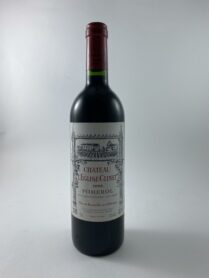Wines of Château l'Eglise Clinet
-

Château l’Église Clinet 1996
€210.00Pomerol | Red | 0,75 L
The history of Château de l’Eglise Clinet
Château l’Eglise Clinet is a 5.5-hectare wine estate located in Pomerol in the Bordeaux region.
In 1803, Jean Pierre Rouchut acquired the land of Château l’Eglise Clinet. Jean Pierre Rouchut died in 1836, and one of his children took over the running of the land. His niece Marie Rouchut was married to Martial Mauléon, and when Jean Pierre Rouchut’s son died, the winery was taken over by Marie Rouchut and Martial Mauléon.
So, in 1882, the Mauléon-Rouchut family re-established the winery.
Château l’Eglise Clinet was created by combining the parcels of Château Clos l’Eglise, which belonged to the de Mauléon-Rouchut family, and Château Clinet Voisin, which belonged to the Constant family. These two castles were the foundation of the château l’Eglise Clinet. It was initially named Clos de l’Eglise-Clinet, because the estate is located right next to the church of Saint-Jean de Pomerol. The church was originally built in the 12th century by the Hospitaller monks of Saint-Jean-de-Jérusalem.
After bringing these two vineyards together, the Mauléon-Rouchut family decided to go into wine production. However, they can’t make a living from their wine production. To remedy this problem, the Mauléon-Rouchut family decided to live on their farm. Their farm provides most of their income. Their wine production reached thirty barrels in 1908.
In 1914, the Mauléon-Rouchut family decided to lease the vineyards for a few years to a merchant, as their son-in-law, who was a merchant, did not wish to cultivate the vineyards of the Château de l’Eglise Clinet.
It was only in 1942 that the family decided to join forces with Pierre Lasserre. He will manage the estate and market the wine produced by Château l’Eglise Clinet. The vines will be leased to Pierre Lasserre, who already ran Clos René not far from Château l’Eglise Clinet. In exchange, Pierre Lasserre provides half of his income.
Forty years later, Denis Durantou decided to put an end to this arrangement. In fact, Denis Durantou studied oenology at Bordeaux University to be able to take over the running of Château l’Eglise Clinet.
He therefore decided to install new equipment and gradually replace the damaged and increasingly unproductive equipment. Thanks to him, over the years Château l’Eglise Clinet has become one of the best. Denis Durantou arms himself with patience and tries to bring all his know-how as a talented and visionary winemaker to bear. This has enabled him to raise the profile of the estate and to become one of Pomerol’s finest wines, represented as rich, elegant and captivating.
In 1950, the decision was taken to rename the château’s wine l’Eglise Clinet. The 1955 vintage was the first to be labelled “Château l’Eglise Clinet”.
As a result, Château l’Eglise Clinet has gained in notoriety and has even become one of the right bank’s finest wines.
In May 2020, Denis Durantou died. The Pomerol appellation loses one of its great performers. Noémie Durantou is now at the helm of Château l’Eglise Clinet, with Olivier Gautrat as cellar master.
Château l’Eglise Clinet vineyard
Château l’Eglise Clinet benefits from an exceptional terroir. Its soils are clay-gravel with steep slopes. These soils enable Château l’Eglise Clinet to drain the vines.
A large part of the vineyard withstood the frosts of 1956, 1985 and 1987.
The climate at Château l’Eglise Clinet is very favorable, thanks to very favorable geological conditions. These elements are the key to producing great wines and standing out from the many châteaux in the Bordeaux region.
Château l’Eglise Clinet has also chosen to cultivate the entire vineyard exclusively by hand, in order to respect the values of the terroir and allow it to express itself freely. The average age of the vines is 40 years, and the grapes are vinified with great rigor and precision.
Château l’Eglise Clinet uses sustainable viticulture methods, giving rise to one of the finest Pomerols, close to Petrus. The grapes are harvested by hand, and the vinification is carried out by a master craftsman.
In fact, Château l’Eglise Clinet covers just 5.5 hectares, which doesn’t allow for much wine production. This small production and high demand explains some of the high prices for Château l’Eglise Clinet.
Château l’Eglise Clinet wines have a relatively high ageing capacity. What’s more, to enjoy a Château l’Eglise Clinet wine at its full potential, it needs between 10 and 12 years of cellaring.
Château l’Eglise Clinet also produces a second wine called Petite Église. The first wine of Château l’Eglise Clinet is described as elegant, rich and well-balanced between fruit and suppleness. Château l’Eglise Clinet’s second wine, Petite Eglise, is just as sumptuous, but can be enjoyed more quickly.
Structure and pairing of Château l’Eglise Clinet wines
Château l’Eglise Clinet is planted with 90% Merlot and 10% Cabernet Franc. These are typical Bordeaux grape varieties. Recent vintages of the wines produced by this château have been characterized by a very fine aromatic expression and a beautiful complexity of flavors. On the palate, this Pomerol wine is a brilliant dark garnet color. The nose is composed of blackcurrant aromas. This is a wine for long ageing.
The finest vintages for Château l’Eglise Clinet are: 2020, 2019, 2016, 2015, 2010, 2005, 2000, 1998, 1989 and 1985.
To enjoy this bottle of wine, we recommend pairing it with braised meat, entrecôte steak with truffle sauce, and hard cheeses for dessert.
Interested in Pomerol wines? Treat yourself to a cuvée of this Bordeaux red wine.
See also our wines for the following domains:
